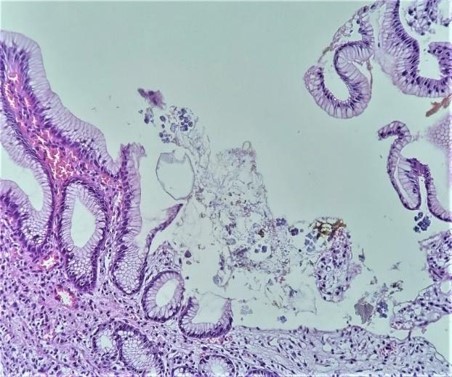SARCINA VENTRICULI IN THE STOMACH: AN UNEXPECTED AND POTENTIALLY DANGEROUS VISITOR
SARCINA VENTRICULI EN ESTÓMAGO: UN VISITANTE INESPERADO Y POTENCIALMENTE PELIGROSO
DOI:
https://doi.org/10.25176/RFMH.v23i4.6132Keywords:
Sarcina ventriculi, dyspepsia, gastritisAbstract
ABSTRACT
Introduction: Sarcina ventriculi is a Gram (+), anaerobic, non-motile cocci, with a fermentative carbohydrate metabolism, that survives and grows without problems in environments with acidic pH. It is a known etiological agent in veterinary pathology, however its pathogenic role in humans is controversial. In recent years, the finding of this microorganism in different anatomical places has been reported in humans with increasing frequency, predominantly in the upper digestive tract, mainly in the stomach, in patients with dyspepsia and/or delayed gastric emptying, some of these cases with serious evolution, even fatal. Clinical case: we report the case of a patient with dyspeptic symptoms, whose gastric biopsy identified Sarcina ventriculi and whose targeted pharmacological treatment ended the discomfort described. To the best of our knowledge, this is the first case reported in Peru.
Keywords: Sarcina ventriculi, dyspepsia, gastritis (Source: MeSH – NLM)
Downloads
References
Canale-Parola E . Biology of the sugar-fermenting Sarcinae. Bacteriol Rev 1970;34(1):82–97 .
Goodsir J . History of a case in which a fluid periodically ejected from the stomach contained vegetable organisms of an undescribed form, with a chemical analysis of the fluid. by George Wilson.. Edinburgh Med Surg J 1842;57:430–43 .
Darch R , Harrison J , Rashid M . Sarcina ventriculi Bacteria in stomach and duodenum of a patient with gastroesophageal obstruction by adenocarcinoma. J Univers Surg 2016;4:46 .
D. Lam-Himlin, A.C. Tsiatis, E. Montgomery, et al., Sarcina organisms in the gastrointestinal tract: a clinicopathologic and molecular study, Am. J. Surg. Pathol. 35 (11) (2011) 1700–1705.
S.C. Sopha, A. Manejwala, C.N. Boutros, Sarcina, a new threat in the bariatric era, Hum. Pathol. 46 (9) (2015) 1405–1407.
Holt S C, Canale-Parola E. Fine structure of Sarcina maxima and Sarcina ventriculi. J Bacteriol 1967; 93: 399-410.
Lowe SE, Pankratz HS, Zeikus JG. Influence of pH extremes on sporulation and ultrastructure of Sarcina ventriculi. J Bacteriol. 1989;171(7):3775–3781.
S.K. Ratuapli, D.M. Lam-Himlin, R.I. Heigh, Sarcina ventriculi of the stomach: a case report, World J. Gastroenterol. 19 (14) (2013) 2282–2285.
B.M. DeBey, P.C. Blanchard, P.T. Durfee, Abomasal bloat associated with Sarcina-like bacteria in goat kids, J. Am. Vet. Med. Assoc. 209 (8) (1996) 1468–1469.
Crowther JS . Sarcina ventriculi in human faeces. J Med Microbiol 1971;4(3):343–50 .
Tolentino LF, Kallichanda N, Javier B, Yoshimori R, French SW. A case report of gastric perforation and peritonitis associated with opportunistic infection
by Sarcina ventriculi. Lab Med. 2003;34(7):535–537.
Laass MW, Pargac N, Fischer R, Bernhardt H, Knoke M, Henker J. Emphysematous gastritis caused by Sarcina ventriculi. Gastrointest Endosc 2010; 72: 1101-1103 [PMID:20538273]
Gaspar BL . The significance of Sarcina in routine surgical pathology practice. APMIS 2016;124(6):436–43 .
Sauter JL, Nayar SK, Anders PD, D’Amico M, Butnor KJ, Wilcox RL. Coexistence of Sarcina organisms and Helicobacter pylori gastritis/duodenitis in
pediatric siblings. J Clin Anat Pathol (JCAP). 2013;1(1):1–3.
M.R.H. Al Rasheed, C.G. Senseng, Sarcina ventriculi review of the literature, Arch. Pathol. Lab. Med. 140 (2016) 1441–1445.

Downloads
Published
How to Cite
Issue
Section
License
Copyright (c) 2023 Revista de la Facultad de Medicina Humana

This work is licensed under a Creative Commons Attribution 4.0 International License.



































